PinotFile: 6.62 July 19, 2008
|
The Golden Era of ArtisansWhen I was a red-headed youngster with a full head of hair growing up in Southern California in the 1950s, there was no such thing as artisan foods. My mother bought our food at a local market and most of it was either frozen or canned. There was not much variety to choose from, so our meals were simple in preparation. Macaroni and cheese, hamburgers, and spaghetti were staples. The terms organic, sustainable, and artisan had not been introduced into the everyday vernacular. Entering the first part of the 21st century, we are blessed with an endless variety of artisan foods. The trend began in the 1980s, but it has fully blossomed in the past several years. The term, artisan, is generally defined as a skilled manual worker or craftsman. With reference to food, artisan refers to small, or boutique, producers of specialized eatables of the highest quality, sourced and produced by passionate people who have committed themselves to foods intended for the most sophisticated gourmands. Examples of artisan foods abound: cheese, chocolate, specialty meats, bread, ice cream, coffee, beer and wine. Take cheese for instance. According to the New York Times, before 1981 there were no goat cheese producers in the United States - now there are more than 200. Specialty cheese stores are now commonplace in big cities. Jeff Roberts, writing in the Atlas of American Artisan Cheese, notes that at least 35 producers now have caves and cellars in the United States where exposure to local microflora promulgates a better and natural aging of cheeses. Artisan beers have exploded on the scene, especially in Canada, Australia, and New Zealand, and the United States has not been far behind. In 2007, there were 1,406 regional craft breweries, microbreweries and brewpubs in the United States. The recent Anderson Valley Pinot Noir Festival was attended by 750 pinotphiles, but the Anderson Valley Beer Festival (BoontBeerFest 2008), which preceded it, drew over 5,000 brewski lovers. The annual Beer Festival in Portland, Oregon, has over 50,000 attendees. Artisan bean-to-bar chocolate makers have sprouted up all over the United States, crafting chocolate with high cocoa content, less sugar, and exotic ingredients resulting in unique flavors with the cocoa origin proudly displayed on the product. These are often micro-batch producers, making only 50-1,000 pounds at a time and only a few people making the chocolate. In a recent feature in the Los Angeles Times, it was estimated that we will see double the number of chocolate makers in the United States over the next three years. Artisanal producers of Pinot Noir are also part of this trend. Not a week goes by that I don’t hear about a new producer in California crafting small lots of Pinot Noir. Just a few weeks ago I received a notice from Bruliam Wines announcing their launch with the release of two single barrel Pinot Noirs, one from Anderson Valley and the other from the Santa Lucia Highlands. Proprietors Keith and Brian Overstreet ask the question, “Can two winemaking novices create world-class Pinot Noir, or will we be begging our foodie friends to buy “premium vinegar?” Everyone wants in on the fun.
 This issue of the PinotFile is dedicated to the artisan vintners who enrich our daily lives. The typical Pinot Noir may be simply 80 percent water, but it is the most superb antidote I can think of to the anxiety of life’s stresses. In the following pages, you will read about some of the most enjoyable group of artisan Pinot Noirs I have ever reviewed and published in the PinotFile (and that is saying something after more than 315 issues). Please temper this bold comment with the realization that these tasting notes are only a guide and all of these wines deserve your attention. At the end of the day, it really doesn’t matter whether you taste allspice, Bing cherries, or rotting leaves, or which wine is packaged in the heaviest bottle with the fanciest label, just yield to the experience, and make the Pinot Noir in your glass your own.
Paul Lato: Paul Lato WinesPaul Lato is a winemaker with quite an international background. He grew up in Poland, pursued professional training as a sommelier in Canada, studied through the Wine and Spirit Education Trust based in London, took a course at the German Wine Academy, and ended up in the Central Coast of California where he arrived to pursue his winemaking dreams. He had no formal training in wine making per se, but worked two harvests as an intern during his years of study to be a sommelier. He was mentored by Jim Clendenen at Au Bon Climat and Bob Lindquist at Qupe during those two harvests, and they became his inspiration. His “distant” mentors have been the late Henri Jayer for Burgundy and the Chave family for the Rhone varietals. Although he never met either of his “distant” mentors, he seriously studied their winemaking and personalities, and drank as many of their wines as possible. It is primarily his tasting experience with their wines that spurred him to use them as role models. One constant among all of the mentors has been his realization that “true artisanal winemaking is based on intuition, sensitivity and passion.” Starting with the 2002 vintage, Paul made six barrels of wine (three barrels of Pinot Noir and three barrels of Syrah). By 2006 he had increased his output to 300 cases total, and currently has 24 barrels of wine from 2007 in this cellar. His quantities remain purposely small. He declassifies up to half of his production that fails to meet his high expectations. He has grown slowly and carefully, limited by his own resources (he spurns investors) and by his insistence on doing every step of the winemaking process himself. Chardonnay has been added to the mix in 2007. His emphasis is on Burgundian varietals with Rhone wines limited to 20% (only Syrah now) of production.
 Although Paul is European in birth and upbringing, he strives to make wines that show “the full potential of California which is blessed with an abundance of sun and proximity to the ocean.” He works with very good vineyards that have a strong personality. Almost all contracts are per acre so he can work intimately with the vineyard managers to achieve his goals. Sorting is done both in the vineyard and in the winery. Paul employs long cold soaks, quite warm fermentations, gravity racking only when necessary, gentle fining and no filtration. He “tries to combine elegance and intensity, always remembering that harmony and balance are most important.” To this end, he has been influenced by the older styles of Williams Selyem Pinot Noir. I have met and talked with Paul on a number of occasions and have always been impressed by his passion. In a past PinotFile I wrote, “Paul Lato bleeds Pinot Noir. He is a rare individual of great passion who is humble, yet aristocratic, both humorous and charming, and with a smile that shows a zest for wine and the good life. Paul told me I was smart to be a Prince, because ‘Kings sit around doing nothing with their clothes off, and Princes actually run the show. They are the most knowledgeable about everything that is going on.’” I recently tasted through the 2006 vintage of Paul Lato Pinot Noirs. I really admire these wines for their purity and refinement. They are all elegant and beautifully balanced. Perhaps their best feature is what they don’t have - what I like to call NOTT (not too much of anything).
2006 Paul Lato “Duende” Gold Coast Vineyard Santa Maria Valley Pinot Noir 14.5% alc., $60. · This vintage is more showy than 2005 and quite a striking wine. Lovely Pinot perfume of dark stone fruits, earth, mushroom, and truffle. Deliciously spiced black cherries with complimentary herbs. This lovely wine slides like silk over the palate. Elegant and seductive.
2006 Paul Lato “Suerte” Solomon Hills Vineyard Santa Maria Valley Pinot Noir 14.5% alc., $60. The Solomon Hills Vineyard is owned and farmed by the Miller family under the direction of vineyardist Greg Phelan. Paul proudly states on the back label, “For those who walk the walk.” · The aromas draw you in as you merrily sniff away. Crushed strawberries, spice, and even fresh-baked chocolate chip cookies waft from the glass. Great sweetness of red fruit highlighted by baking spices and brown sugar. The finish is long and tangy and the balance is spot on.
2006 Paul Lato “Sine Cera” Fiddlestix Vineyard Ste. Rita Hills Pinot Noir 14.7% alc., $65. Fiddlestix Vineyard consists of 97 acres of Pinot Noir of which the first plantings began in 1998. Located on the north side of a tight eastwest running valley, fog hangs over the vines until midmorning and the temperature barely rises above 75°F. The vineyard is farmed by Coastal Vineyard Care (Jeff Newton and Larry Finkle). Paul declassified 60% of the wine. · This wine is all about power with finesse. The Fiddlestix fruit can be foreboding, but Paul has tamed the beast beautifully. This wine is the “dark side” of Paul Lato. Very pleasing nose of black cherries and savory herbs. Great sweetness of dark red fruit which gets tastier and tastier in the glass over time. Powerful, yet very clean, pure and refreshing. This one has the bling without the weight.
2005 Paul Lato “Duende” Gold Coast Vineyard Santa Maria Valley Pinot Noir 14.3% alc., 75 cases, $50. The Gold Coast Vineyard is owned and farmed by the Burk and Espinosa families and the vines are over sixteen years old. · Slightly lighter in color than the 2006 wines. Complex aromatic profile brimming with dark red fruits, brown sugar, spice, hay and barnyard. Black cherry driven with hints of anise and char. Lightly fruited on the palate and very feminine in presentation.
At the recent Fiddlefest held at Fiddlestix Vineyard (June 22, 2008), a barrel sample of the 2007 “Sine Cera” Pinot Noir was sampled and it was ready for action now, straining to get out of the blocks. It will be a stunning wine. In 2009, Paul will be sourcing grapes from the renowned Pisoni Vineyard in the Santa Lucia Highlands. Paul Lato Wines are sold primarily through a mailing list at www.paullatowines.com. There is limited retail distribution. Look for Paul at the annual World of Pinot Noir.
Thomas Brown: Rivers-MarieThomas Rivers Brown and his wife Genevieve Marie Walsh have quietly developed one of California’s most cherished Pinot Noir labels. Thomas hails from South Carolina and was educated at the University of Virginia. In college he majored in English literature and game theory, two subjects about as distant from enology as possible. He arrived in California in 1996, loving wine and wanting to play the game, but with no leads or connections whatsoever. He started knocking on doors and finally Aaron Jordan hired him at Turley. This was to become a very fortuitous hire as Aaron subsequently introduced Thomas to Scott and Joan Zeller, the owners of the 6 acre Summa Vineyard in the Occidental region of the true Sonoma Coast. Early on (2002 was the first Rivers-Marie Pinot Noir release), Summa Vineyard was the only source of Pinot Noir for Thomas, but led to other grape acquisitions in the area. Today, Rivers-Marie produces very small amounts of Pinot Noir from three vineyard sources in the true Sonoma Coast, specifically the Occidental-Freestone area. Besides Summa Vineyard, grapes are sourced from the Occidental Ridge Vineyard (owned by Richard and Darla Radcliffe) which debuted in 2005, and the Willow Creek Vineyard (2 acres owned by Raleigh and Patricia Wilson-Juckett) which debuted in 2006. Total production for Rivers-Marie in 2007 is 650 cases. Its no wonder that there are 4,000 people on the waiting list hopelessly bidding their time for a spot on the mailing list. Managing allocations is a lot more difficult than crafting the wines. Thomas also has a hand in crafting wine for fifteen different wineries in Napa, processing 300 tons of grapes annually, primarily Cabernet Sauvignon. He plans to move his own production to the Black- Sears Winery on Howell Mountain in Napa that Ted Lemon is leaving behind (Ted’s new winery opens later this year). He also has a second Pinot Noir project, Aston Estate, sourcing Pinot Noir from the Annapolis region of the true Sonoma Coast (see comments and reviews at the end of this feature). I met up with Thomas at the end of June, 2008. He warmly welcomed me into his home to taste barrel samples of the 2007 lineup of Rivers-Marie Pinot Noirs. Thomas had finished the blends and was planning to bottle the wines in August. He noted that in 2007 there was no problem with frost in the Occidental- Freestone area with perfect set (as in 2004). The lineup was quite impressive and at the end of my tasting notes my final words were “beautiful pinotypicity.” All of the wines had fresh, bright aromas and vibrant acidity. Alcohols were moderate and oak treatment unobtrusive (new oak can vary from 50% to 100% depending on the grape sources). These are truly artisan wines of exceptional breeding.
2007 Rivers-Marie Sonoma Coast Pinot Noir Aromas of bright cherries carry through to the finish. Delicious and juicy, with lively acidity on the finish. Needs a little time to shed refined, but notable tannins.
2007 Rivers-Marie Willow Creek Vineyard Sonoma Coast Pinot Noir 3 barrels. · Complex and comforting nose featuring cherries, floral perfume, and oak spice. Not particularly giving now with reticent earth-imbibed cherry flavors. Quite gentle with finely ground tannins.
2007 Rivers-Marie Summa Vineyard Young Vines Sonoma Coast Pinot Noir Touch reduced at present. Sweet red stone fruit charge with herbal and orange peel highlights. Immensely satisfying finish that won’t let go.
2007 Rivers-Marie Occidental Ridge Vineyard Sonoma Coast Pinot Noir Clones 115, 777. · The deepest colored wine in the lineup. Plenty of acidity that is hidden by the fruit richness present. Mouthcoating aromas and flavors of fresh berries, mocha, and graham. A Lolita, but still hitting plenty of high notes.
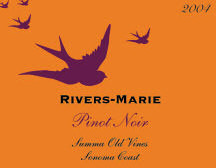 2007 Rivers-Marie Summa Vineyard Old Vines Sonoma Coast Pinot Noir Exotic scents of wild berries, spices, and graham. Plummy dark fruit with sinew which is brooding, rich and plush, but retains a degree of finesse. Tangy acidity provides juiciness. A wine to contemplate.
Rivers-Marie wines are sold exclusively through a mailing list which has been full for some time now. You can add your name to the waiting list at www.riversmarie.com, but you might be better served to seek out a few bottles on the secondary market. A Chardonnay from Thieriot Vineyard located in the true Sonoma Coast will be available in 2007. There is also a Rivers-Marie Cabernet Sauvignon from Howell Mountain. Releases to date: 2002 Summa and Summa Old Vines, 2003 Summa and Summa Old Vines, 2004 Sonoma Coast, Summa and Summa Old Vines, 2005 Occidental Ridge, Summa and Summa Old Vines.
Aston Estate was launched in 2004 by three partners including Thomas Rivers Brown and Frederick and Carol Schrader of Schrader Cellars. Schrader Cellars specializes in Cabernet Sauvignon which is vinified by Thomas Rivers Brown and has been highly praised by the Wine Spectator. Grapes are currently sourced from a 14-acre site in Annapolis that is warmer than the Occidental-Freestone area. The Aston Estate style is different than the Rivers-Marie Pinot Noirs and is largely dictated by Frederick Schrader’s palate. The grapes are picked riper, the wines are fruit-driven and are less acid-driven, and they exhibit a blacker fruit profile. Thomas describes it as “an old Central Coast style .” The clones used are Dijon 115, 667, 777 and Swan Selection. Yields are small, less than 1.25 tons/acre. A new vineyard is now being planted in Cazadero to California heritage clones.
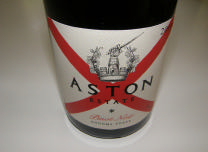 2005 Aston Estate Sonoma Coast Clone 777 Pinot Noir 14.7% alc., $70. · Dark reddish-purple. Clean aromas of Chinese plum sauce, blackberries and fresh oak. Tart black cherry and anise flavors with a citrus note on the finish. Acidity is a little too much now. Needs food.
2006 Aston Estate Sonoma Coast Clone 777 Pinot Noir 14,7% alc., $70. · Subdued nose showing demure black cherry and wild herb aromas with a whiff of alcohol. Substantial dark red fruit core with a hint of chocolate. The wine is quite withdrawn at present. Nicely balanced with a clean finish. This shows good potential and will benefit from another one to two years in bottle.
2006 Aston Estate Sonoma Coast Clones 115, 777 Pinot Noir 14.6% alc., $70. · Intriguing perfume of underbrush, forest floor and dark red cherry with a nice hint of oak. The wine shows a soft core of tannin wrapped in layers of luscious cherry and raspberry fruit, providing a fullness that envelopes the tongue. Everything is in beautiful balance and the combination of two clones provides more interest than the single clonal wines described above. This was downright terrific the next day when sampled from an opened, re-corked bottle.
Aston Estate Pinot Noirs are currently in limited retail distribution. The Aston Estate website is not operative and I am assuming an offering was sent out to current mailing list members of Schrader Cellars.
Augie Hug: Hug CellarsAugie Hug was raised in Northern California, graduating from Ponderosa High School in the small town of Shingle Springs in 1974. Right out of high school, he began working in the oilfields, drilling natural gas wells, oil wells, and geothermal wells in California. He continues in this profession to this day, now acting as a supervisor and consultant in the oilfields. Since 1998, he has worked in China, Alaska, Australia/East Timor, as well as California. Because the oilfields business has been historically cyclical, Augie has pursued many other jobs during the lulls. In 1986, he became the chef and owner of a small restaurant in the mountains north of the Napa Valley. It was here that he developed a love for wine and an interest in the partnership of wine and food. His wine epiphany was clear. At a dinner with some of his associates from the oil business, he tasted his first Heitz Martha’s Vineyard Cabernet Sauvignon. It was the famed 1974 vintage and he says, “it was as if someone turned on a light for me.” That single bottle of wine has sent him on a life-long vinous journey. In 1993, along with his wife Raquel, he purchased a wine shop and tasting room in the artists’ hamlet of Harmony, in California’s central coast. It was called the “Central Coast Wine Room.” Together, they focused on small artisan producers and through the wine shop met and became friends with many of those winemakers. One winemaker in particular was John Alban of Alban Vineyards. One night at dinner, John graciously offered to assist Augie in making wine. In 1994, Hug Cellars was launched with a mere 87 cases of Syrah made from grapes purchased from Alban Vineyards. John became a valuable mentor and Augie made his wines at Alban Vineyards for nine years. In 2003, Augie moved his winemaking to a shared facility with Mat Garretson of Garretson Wines in Paso Robles, California. In 2004, Augie leased a building next door to Garretson Wines and now has his own winery.
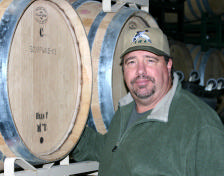 The first Hug Cellars Pinot Noir was crafted in 2001. Current total production is 1,700 cases with about a third of that being Pinot Noir from four different sources (Rancho Ontiveros in the Santa Maria Valley where Augie is currently planting three acres of Pinot Noir, Cedar Lane Vineyard in Arroyo Seco, Casa Torres Vineyard in the Santa Maria Valley, and the organically farmed Boulder Ridge Vineyard in Cambria). There have been many winemakers who have framed Augie’s winemaking style. Besides John Alban, these include Paul Wilkins, Steve Rasmussen, Bob Lindquist, and Ted Lemon. Augie strives to make wines that “are unique and express a sense of place.” He describes his winemaking style as a “nonstyle,” meaning he tries not to interfere too much with the vineyard so that the purity of fruit can speak for itself. His wines are not over-stylized, and what he terms “trendy.” Rather, they represent attempts to create something classic and elegant. He follows the traditional winemaking path for Pinot Noir, fermenting the wines with indigenous yeasts, and utilizing a good percentage of whole cluster. I had the pleasure of sampling the 2006 Pinot Noirs from Hug Cellars. The theme of all the wines was a very admirable harmony, and a pleasurable, but not imposing, oak flavor touch.
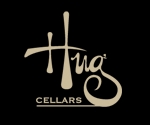 2006 Hug Cellars Paso Robles Pinot Noir 14.9% alc., 95 cases, $25 (sold out). · This is the darkest-colored and highest alcohol percentage wine in the lineup. That said, this is a very good wine with admirable balance. The wine is alive with the scent of ripe berry fruit, cherry gumdrops, and oak vanillin. Rich and sweet strawberry and raspberry fruits cascade through the palate with an appealing richness. The texture is smooth as silk, the tannins are fine-grained, and the finish fades softly into memory. Charming.
2006 Hug Cellars Cedar Lane Vineyard Arroyo Seco Pinot Noir 14.2% alc., 190 cases, $30. Clones 115 and 777. Aged in 20% new oak for 11 months. · Lightest reddish-purple color of the lineup. Oak infused red fruits dominate the Pinot scents with a touch of alcohol and ?cedar (was I influenced by the vineyard name?). Very discreet and charming red fruits with a nice touch of oak. Gentle and easily approachable, this lovely Pinot features a clean, lifting, and refreshing finish that hugs (sic) you back to the glass.
2006 Hug Cellars Casa Torres Vineyard Santa Maria Valley Pinot Noir 14.1% alc., 45 cases, $40. 25% whole cluster. Clone 23. Aged in 30% new oak barrels. · Sappy red cherry aromatic core with hints of fresh-sewn oak, smoke and a touch of heat. This delicious wine is quite distinct and interesting in its flavor profile which includes both raspberry and blackberry fruits and a good dose of Santa Maria white pepper and spice. With svelte tannins, this is a polished and enticing wine.
2006 Hug Cellars Rancho Ontiveros Vineyard Santa Maria Valley Pinot Noir 13.7% alc., 45 cases, $48 (sold out). Clones 1A and 2A. · I found that this wine was in a dumb phase currently which accentuated the oak. The aromatics are shy in fruit with plenty of toast, grilled cheese and char evident. There is a prodigious core of beautiful deep red stone fruits with a sidecar of herbs and plenty of char and grilled meat flavors. The texture is pillowy. Currently the oak overpowers the fruit and this wine will benefit from cellaring to allow the fruit core to meld with the oak.
Hug Cellars wines are sold primarily through a mailing list at www.hugcellars.com. There is some retail distribution (check www.vinquire.com). The winery and tasting room is located at 2323 Tuley Rd, Paso Robles. Tasting is available from Thurs-Mon, 11-5 and by appointment. The phone is 805-226- 8022.
William Hunter: ChasseurBill Hunter is one of the “Wild Men of West County,” the band of winemakers interested in the Pinot Noir grown in the true Sonoma Coast region around the towns of western Sebastopol, Freestone, and Occidental. Hunter developed an early interest in wine working as a wine steward at the Chronicle Restaurant in Pasadena, California. The Chronicle Restaurant was famous for its wine cellar and some of its rarest bottles had come from the acquisition of the private collection of Alfred Hitchcock. I went to this restaurant on a number of occasions and probably ran into Hunter during my formative wineloving days. He went on to enroll and graduate from University California Davis (1987), and gained his early winemaking experience at Rombauer, Bonny Doon and Chauffe-Eau Cellars. In 1994 he began making some wine on the side, starting with two barrels of Dutton Chardonnay and one barrel of Carneros Pinot Noir. Soon he started his own label, Chasseur, the French term for Hunter. In 2002, he brought on Alex P. Barhtolomaus, Managing Director of Billington Imports as an investment partner, and Hunter was able to devote himself fully to winemaking. He now produces 5,000 cases of Pinot Noir and Chardonnay at his winery in Sebastopol, located inside the old apple processing plant on Gravenstein Highway.
 The lineup of Pinot Noirs is quite impressive, particularly the single vineyard bottlings which are all quite distinctive, complex, and blessed with appealing charisma.
2006 Chasseur Russian River Valley Pinot Noir 14.1% alc., 825 cases, $36-$40. Aged 15 months in oak. · Nice Pinot aromas of Bing cherry, baking spice and barnyard. Light, elegant and demure in the mouth revealing red berry and red cherry flavors accentuated with savory herbs. Soft in the mouth with a clean and somewhat persistent finish. Very drinkable, but may lack punch for serious fruit lovers.
2006 Chasseur Sonoma Coast Pinot Noir 14.1% alc., 620 cases, $36-$40. Primarily multiple Dijon clones with a little Swan selection. Aged 17 months in barrel. · Rich and heady nose showing ripe dark berries and cherries and a complimentary hint of oak. More fruit and more interest than the Russian River Valley bottling. This wine speaks more of the soil with more herbs, more sinew, and more grainy tannin along with mineral-imbibed dark fruits.
2005 Chasseur Sonoma Coast Vin Gris 14.2% alc., 100 cases. · Very pretty light peach color. Interesting aromas of berries, lemon peel, marzipan, and oak. Stone fruits on the palate with citric zest. Seems to have lost its fresh edge and now tastes a bit old with a hint of sherry flavor. A wine to enjoy on release.
2005 Chasseur Freestone Station Russian River Valley Pinot Noir 14.1% alc., 150 cases, $60 (sold out). Clones 115, 777 and 23. Aged 15 months in barrel. · Unusual, but pleasurable, aromatic profile of black cherry jam, gingerbread, almonds and smoke. An earthy wine featuring dark stone fruits and cola flavors presented in a softly textured style. Nicely balanced.
2005 Chasseur Sexton Russian River Valley Pinot Noir 14.1% alc., 150 cases, $60 (sold out). This wine is a collaboration between Bill Hunter and grower James Pratt. Dijon clones 113, 114, 115, 777, and 828. Aged 15 months in oak. · Hi-toned and complex aromas of crushed black cherries, smoke, tobacco, herbs (sage), grass, and a hint of warmth. This wine shows the burly and primal side of Pinot Noir with intense and super ripe dark fruits (even tending to raisin and prune flavors), wrapped in a earthy, mushroom flavored cloak. The finish retains some lively acidity and lingers for a very long time. This one leans toward the Cab camp and will appeal to lovers of ripe fruit flavors.
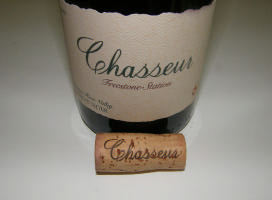 2005 Chasseur Sylvia’s Russian River Valley Pinot Noir 14.1% alc., 100 cases, $60 (sold out). A collaboration between Bill Hunter and the Dutton Family. · Very appealing wild berry, chocolate, and char scents leading to a full array of red fruits and attention grabbing baking spice. An elegant wine that is only marred by a hint of green tomato and stem which tends to dissipate with time in the glass.
2005 Chasseur Twin Hill Sonoma Coast Pinot Noir 14.1% alc., 75 cases, $60 (sold out). Aged 15 months in barrel. A collaboration between Bill Hunter and Benjamin Hurst. · Perfumed with cherry candy, violets, cinnamon and oak. Redder Pinot fruits with savory herbs and spice. Seamless and all silk and satin. Tangy acidity brings up the finish. The most charming wine of the lineup to drink now and the one to take to the dance this weekend.
Chasseur wines are highly allocated and sold primarily through a mailing list. The two appellation Pinot Noirs are produced in larger quantities and are available in the fine wine retail market throughout the United States. The informative website is www.chasseur.com. Chasseur operates under the LLC, Hunter Wine Cellars. The phone number is 707-829-1941. Note: After tasting the four vineyard-designate Pinot Noirs, I blended an equal part of all four together (don’t try this at home). The resulting wine was quite good, with an intensification of dark fruit and noticeably more full-bodied. Not surprisingly, however, the blend lost the many subtleties of the individual wines. Obviously, this is why the winemaker bottles the wines separately.
Kent Humphrey: Eric Kent Wine CellarsKent Humphrey’s interesting story has been told in previous issues of the PinotFile (see Volume 6, Issue 43). Just to recap here I would say that he is another of the modern group of talented Pinot Noir winemakers who have learned by experience rather than through a formal enology education. His initial life path was in the advertising field which he pursued over a ten year period, finally deciding to depart due to the disdain for big corporate business tactics. Those ten years were not without a plus side, however, Kent sampled, savored, collected, and delighted in wine. When he finally chose to leave the advertising world, his family and friends encouraged him to seek a career in winemaking. He considered entering University California Davis for formal training, but realized that many of the wines he most admired were crafted by people who had no academic training in winemaking. Kent embarked on some hands-on experience at two different winery facilities. After a few years, he was offered some top-notch Pinot Noir fruit and the Eric Kent label was founded. He chose to make Pinot Noir, Chardonnay and Syrah, since these were the varietals that gave him the most drinking pleasure. He released 375 cases in the inaugural 2003 vintage. Kent has grown slowly, planning to stay small, and stopping somewhere between 3,000 and 4,000 cases annually. Kent and his wife, Colleen, an accomplished artist, decided over dinner one day to showcase artists on their bottle labels. The two work in harmony, she assisting him in making blending decisions, and he helping her in choosing the individual art works that are chosen to grace the bottles of Eric Kent wines. The works of art that grace the front label of every Eric Kent wine are unique for every vintage. The art is from deserving, but as yet undiscovered talents. Each artist brings a unique vision to the label that compliments the spirit behind the wines. The art work brings an added dimension to the wine by providing a basis for discussion as the wine is imbibed.
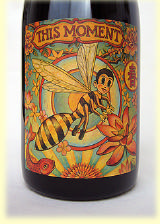 2006 Eric Kent Wine Cellars Windsor Oaks Vineyard Russian River Valley Pinot Noir 14.7% alc., 220 cases, $39. Label artist is Sabrina Ward Harrison. · Demure scents of dark red berries, cherries and hay. Clean and bright flavors of redder fruits and savory herbs. Brisk acidity on the tangy finish.
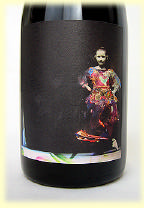 2006 Eric Kent Wine Cellars Stiling Vineyard Russian River Valley Pinot Noir 15.1% alc., 374 cases, $42. Label artist is Tony Speirs · Black cherry, plum, buttered toast and forest floor aromas lead to a mouthful of rich, dark stone fruits that wrap around the tongue and leave a little warmth in their wake. Velvety texture, commendable oak integration, and a decent length to the finish. The darker side of Pinot Noir. This wine will have fans.
Eric Kent Wine Cellars is located in Santa Rosa, California. The wines are crafted at a Santa Rosa custom crush facility. Members of the winery’s E/K Direct Club receive 20-25% discounts. Join the Club at www.erickentwines.com. 707-527-9700. Most of the wine is now sold to E/K Direct Club members. This is so Kent can guarantee that all new club members can order up to a half a case of any or all of the wines as part of their pre-release club shipments. There is limited retail distribution. Kent also crafts two outstanding Chardonnays: a Russian River Valley and Sonoma Coast bottling. The Syrahs have been highly praised in the wine press. At the recent Pinot Days event in San Francisco, I tasted the 2007 vintage of the Stiling Vineyard and Windsor Oaks Vineyard Pinot Noirs as well as a new vineyard source, the Carey Vineyard in the Sonoma Coast. All three of these wines are praiseworthy.
Terry Bering: Castalia WinesTerry Bering started out as a gargariste, crafting Cabernet Sauvignon in a friend’s carport in Healdsburg in 1983. His first Pinot Noir came in 1985. After meeting Tom Rochioli, Bering worked the 1988 and 1989 crush at J. Rochioli Vineyards on Westside Road in Healdsburg. In 1990, he left his real estate job to work as the cellar master at J. Rochioli Vineyards. In 1992 he founded his own label, Castalia Wines, based on purchased grapes from the Rochioli Vineyard. Bering is now a hard-core pinotphile, drinking Pinot Noir almost exclusively. Castalia refers to Apollo’s favorite spring on Mount Parnassus in ancient Greece that bestowed drinkers of the spring gifts of poetry and inspiration. Bering produces a single Pinot Noir, sourced in 2006 from Rochioli’s 19 yearold River Block Vineyard and an 18 year old block planted to West Block clone (Flax Vineyard on Westside Road).
 2006 Castalia Rochioli Vineyard Russian River Valley Pinot Noir 14.1% alc., 328 cases, $50. · The nose is brimming with black cherry fruit accompanied by subtle dried herbs, smoke and char. Restrained but generous dark red fruits, especially black raspberry, coat the mouth and are complimented by stylish oak spice. The wine sports a refined mouth feel and the right touch of acidity. An engaging Pinot Noir of the highest quality and one that Apollo would have surely enjoyed.
Castalia Wines are available from the website at www.castaliawines.com. Simply e-mail Terry Bering with your order. Magnums are available as well.
Michael Browne: Kosta BrowneKosta Browne proprietors Michael Browne and Dan Kosta are alumni of a noted Sonoma County restaurant, John Ash and Co. (see PinotFile, Volume 6, Issue 58). In 1997, they decided to launch a wine venture and put all of their tip money into a an envelope for safe keeping. After raising $2,600, they bought a half ton of Pinot Noir grapes, a single barrel, and a used, hand cranked de-stemmer-crusher to produce their first vintage. In 2001, Michael and Dan partnered with Chris Costello and his family and utilizing a fiscally conservative, yet thoughtful business plan, have managed to earn an exalted reputation for creating world-class California Pinot Noir. Current production for the 2006 vintage is 10,500 cases. Recently Kosta Browne moved into a spacious new winery at the old apple processing plant on Gravenstein Highway in Sebastopol (see photo below). They acquired a long term lease on an 18,000- square-foot warehouse and partitioned the empty space into different sections dedicated to separate winemaking functions. Shane Finley has continued on as Associate Winemaker to assist in production. Some new equipment has been purchased, including large capacity oak barrique fermentors (photo below) to extend the fermentation curve, and a modern basket press. I met up recently with Michael Browne at his new winery to taste through the 2006 lineup of Kosta Browne Pinot Noirs. I sampled a number of barrels from the 2007 vintage as well including wines from the Dutton Manzana Vineyard in the Sonoma Coast, Terra de Promissio Vineyard in Petaluma, and Gap’s Crown Vineyard in the Sonoma Coast. Like many 2007 vintage Pinot Noirs I have sampled from barrel, these are showy, precocious wines that should be spectacular upon release. The 2007 Kanzler is ridiculously good right now. Michael told me he is developing new vineyard sources including 10-20 acres on Occidental Road and 28 acres near Annapolis, both in the true Sonoma Coast. The future plans call for production figures of 11,000 to 11,500 cases of Pinot Noir annually. The mailing list is full at this time, but there may be opportunity for some on the waiting list to join as production expands modestly.
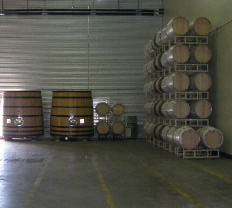  The 2006 vintage produced grapes that ripened early so that alcohol levels have been mildly reduced. The aromatics continue to be a bit tight, and the wines are somewhat reserved at this point. Michael says that “2006 was a beautiful vintage, giving us focused and pure wines with a sense of elegance, precise power and balance.” The two appellation Pinot Noirs assembled from multiple single vineyard lots as well as from other vineyards specifically chosen for these blends were released in February, and the remaining wines are scheduled for an October, 2008 release. With the 2006 vintage, Kosta Browne had 430 barrels comprised of 75 different lots, which contained 430 micro lots. No barrels are racked, so every barrel is unique and Michael took six weeks to blend these individual wines into nine distinct Pinot Noirs. Photo on the next page shows Michael (left) and Dan (right).
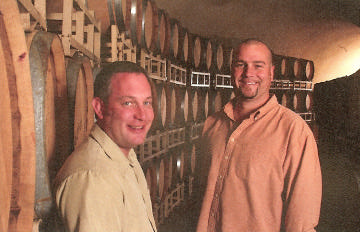
2006 Kosta Browne Russian River Valley Pinot Noir 14.9% alc., 3,400 cases, $48. · A bit tight, but still delivers a nice aromatic lift of strawberries, plums, and spice. The flavors echo the aromas with added notes of cola and oak vanillin. Finishes clean with lingering aromatic pleasantries.
 2006 Kosta Browne Sonoma Coast Pinot Noir 14.8% alc., 3,400 cases, $48. Primarily sourced from the Petaluma Gap region, especially Gap’s Crown Vineyard. · More structured and brambly with notable layers of black cherry, herbs, and toasty oak. Rich and earthy with reigned-in tannins.
2006 Kosta Browne 4-Barrel California Pinot Noir 14.9% alc., 101 cases, $68. This is a selection of barrels that work together well and varies with each vintage. The California appellation designation frees Michael to choose from all of his fruit. This wine consists of 1 barrel each of Rosella’s, Kanzler, Gap’s Crown, and Miron vineyards. · When you stick your nose in this one, the hair stands up on the back of your neck. Cherries, strawberries, rhubarb pie, cola, root beer and several things I can’t describe. The palate is rich, round, mature and sweet. Very pleasing and a wine to contemplate. For hedonists only.
2006 Kosta Browne Amber Ridge Vineyard Russian River Valley Pinot Noir 14.8% alc., 724 cases. $68. Dijon clones 115, 667, and 777. Michael calls this vineyard a “canary in a coal mine,” meaning it varies significantly from vintage to vintage and stylistically can be light in some years, heady and rich in others. · Not as big and robust as the 2005 vintage. Earth imbibed black cherry and wild berry fruit with only moderate acidity and tannins. Nicely balanced.
2006 Kosta Browne Garys’ Vineyard Santa Lucia Highlands Pinot Noir 14.8% alc., 365 cases, $68. Pisoni clone. · Musky nose. Black cherry, sassafras and cola flavors with an earthy and forest floor underpinning.
2006 Kosta Browne Kanzler Vineyard Russian River Valley Pinot Noir 14.9% alc., 724 cases, $68. Wines from this vineyard have a mind of their own says Michael. Dijon 115 and 667, and Pommard 10% whole cluster. · This is one of the most complex wines of the lineup. Also one of the heftiest and most tannic. There is a dense and chewy core of black cherry and black berry fruit that needs time to emerge. All kinds of things going on here in concert with the fruit including aromas and flavors of mushrooms, rose petals, underbrush, and wet oak. Give this one a couple of years.
2006 Kosta Browne Keefer Ranch Green Valley Pinot Noir 14.7% alc., 556 cases. $68. Six clones including Pommard 5, Dijon, and Wädenswil. Michael says this wine usually exhibits plenty of acidity due to its very cool location. Refer to feature on Keefer Ranch Vineyard on page 13. · This is an outstanding Pinot Noir that has a rich core of red berries and cherries that expands in the mouth, coats the tongue, and proceeds to a lengthy and refreshing finish. This one has the whole package.
2006 Kosta Browne Koplen Vineyard Russian River Valley Pinot Noir 14.8% alc., 724 cases, $68. A 5-acre vineyard planted to Dijon clone 667 on the east side of Olivet Lane. The location is one of the warmest for Kosta Browne and yields are generous. The grower is extremely passionate. 25% whole cluster. · Wild and fruity, brambly and earthy, with dark berries and chocolate carrying the flavor parade. Firm tannins. Noticeably, but discreetly concentrated.
2006 Kosta Browne Rosella’s Vineyard Santa Lucia Highlands Pinot Noir 15.0% alc., 365 cases. $68. Mostly Pisoni clone with 20% Dijon clone 828. No whole cluster. · Intense but pretty cherry aromas and flavors. The palate is rich, long, pure and showy. Plenty of vim and vigor. Along with the Keefer, the sleekest and most refined at this stage.
Michael Browne is slowly defining his best vineyard sources and getting familiar with them. His style will always be intensely fruit-driven, but he aims to retain pinotypicity. Michael feels his wines will “taste pretty damn good” for one to five years after release. How long they will age is uncertain. He has gradually lowered his alcohol levels and is shooting to obtain ripeness at between 14.0% and 14.5% alcohol in current and future vintages. He uses Francois Freres and Taransaud French oak barrels exclusively, 20 to 50 percent new depending on the blend. Michael has reached a point of admirable consistency as shown by the lineup of wines above and he is deserving of all of the accolades that he has received in recent years. Join the Wait List at www.kostabrowne.com to obtain future allocations as they become available. The wines are placed on a number of fine restaurant wine lists. Both Michael and Dan participate frequently in charity wine auction events as well as major Pinot Noir festivals. The winery is not open to the public.
Marcy Keefer & Craig Strehlow: Keefer RanchKeefer Ranch is located near the headwaters of Green Valley Creek, with gently sloping, well-drained, south-facing exposure. It was started in 1989 on the site of a former apple orchard in Sebastopol, California. Part of the Green Valley sub appellation of the Russian River Valley (officially now named “Green Valley of Russian River Valley”), Keefer Ranch is planted on Goldridge Loam which drains well and is thus particularly valued for its suitability for growing Pinot Noir. The Green Valley is defined by the fog and is usually the first place where the fog comes in through the Petaluma Gap, and the last place where the fog burns off, making it the coolest and foggiest part of the Russian River Valley. Many years ago the area was considered too cool for ripening Pinot Noir, but pioneering winegrower Warren Dutton’s early plantings (Chardonnay first planted in 1967) here proved otherwise.
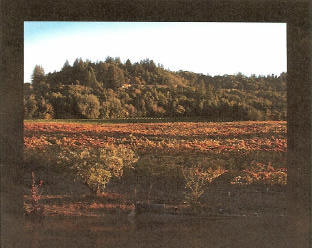 The typical flavor profile of Green Valley shines through in the Keefer Ranch wines. Pinot Noir shows ripe fruit (cherry and cranberry), sweet spice, lively acidity, soft tannins, supple texture and beautiful structure. Chardonnay presents a clean, fresh, crisp, Gravenstein apple, complex citrus flavor profile, with a core of minerality, long finish, and great focus. Keefer Ranch is farmed by Marcy Keefer and her son Craig Strehlow (pictured below with Craig’s wife, Julie, at Pinot Days, 2008). The clones are a nice mixture of Dijon 115, Pommard 5, Mariafeld (23) and Wädenswil (2A). For many years, Keefer Ranch Vineyard has supplied grapes to notable Pinot Noir specialists including most recently, A.P. Vin, Failla, Freeman, Kosta Browne, Loring Wine Co., Pali, and Siduri. Beginning in 2006, Marcy Keefer and her son Craig Strehlow launched their own Keefer Ranch label. Craig is handling the winemaking duties, and the inaugural release is quite impressive. I tasted through every 2006 Keefer Ranch vineyard-designate Pinot Noir and the following four were the most out-standing.

2006 Keefer Ranch Russian River Valley Pinot Noir 14.2% alc., 143 cases, $42. · Light reddish-purple in color. The nose offers fresh savory herbs with red berries and cherries. Delicious delicate red fruits that are sweetly spiced and elegantly presented. Soft and silky like red lingerie. A delight to drink. Naomi Campbell on a Victoria Secret runway.
2006 Failla Keefer Ranch Russian River Valley Pinot Noir 14.1% alc., $45. · Confected cherries, exotic spices, and dried herbs fill the nose. Delicious and juicy black cherry flavor with a sidecar of anise and savory herbs. Silky smooth and seamless with diaphanous tannins. A little bigger than the Keefer Ranch label, but hard to choose between them.
2006 Freeman Vineyards & Winery Keefer Ranch Russian River Valley Pinot Noir 14.2% alc., $46. · Moderately deep ruby color. A cherry bombast on the nose. Saucy, fat and lush black cherry core. Appealing earthy touch. Clean, crisp and tangy finish that lasts and lasts. Naomi Campbell in hiking boots.
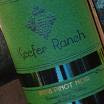 2005 Kosta Browne Keefer Ranch Russian River Valley Pinot Noir 14.9% alc., 117 cases, $62 · Medium light reddish-purple in color. Enticing aromatics offering Bing cherry, sweet spice, brown sugar, herbs and toast. Plenty of concentrated cherry flavor with wild herbs that leap out. Complimentary oak char. Nice finesse and lively acidity on a clean finish. The alcohol is submerged.
Keefer Ranch Pinot Noir is sold through a mailing list and on the website at www.keeferranch.com. 707-829-5950.
Rod Berglund: Joseph Swan VineyardsThere has been a lot written about colorful Joseph Swan (see PinotFile, Volume 5, Issues 25 and 28) and his Pinot Noirs are now legendary. In 1967, at the age of 45, Joe bought a run-down Zinfandel vineyard, barn and house on Laguna Road in the Russian River Valley. The house at one time had been the general store for the tiny town of Trenton which is no longer in existence. The area, called the Laguna Ridges, is only a few miles from the Middle Reach along Westside Road, but the climate is cooler, foggier, and wetter. Andre Tchelistcheff had suggested to Swan that he plant Pinot Noir in this cool area. In 1968, he did exactly that. He retired from his job as a pilot for Western Airlines, and after harvesting the planted Zinfandel that year, began a replanting of the 10-acre vineyard to Pinot Noir, Chardonnay and Cabernet Sauvignon. The original Pinot Noir clones planted here came from Mt. Eden in the Santa Cruz Mountains (via France, Paul Masson, and then Martin Ray). The Mt. Eden budwood was actually a field selection, not a true clone. Joe’s Trenton Estate Vineyard Pinot Noir prospered and cuttings, termed Swan Selections or (incorrectly) Swan Clone, were used by numerous vineyards in California and continue to be planted in various sites today. Over the years, some DRC “suitcase” cuttings were added to the vineyard. Today, there are twelve different clones in the Swan Trenton Estate Vineyard. Swan’s legacy will include his popularization of the old, Burgundian winemaking methods (use of French barrels for aging, manual punch downs), his search for better clones, his experiments with whole cluster fermentation and the age ability of his Pinot Noirs.
 Rod Berglund has carried on Swan’s legacy admirably. Rod began his winemaking career in 1979. In 1986, he married Lynn Swan, and helped Joe with his last harvest in 1987. Joseph Swan passed away in 1989. Rod has maintained Joe’s vision, and continues to produce wine reflective of the style that Joe promulgated. Rod is opposed to the over-the-top, high extract, high alcohol, over-oaked, “tailgate” wines. As he has observed, “There seems to be a growing number of people who are embracing the concept of wines with food, who understand what it takes for wines to age gracefully, and who are looking for elegance and complexity instead of sheer power.” The flagship wine of Joseph Swan Vineyards remains the Trenton Estate Pinot Noir. Rod replanted half of the Trenton Estate Vineyard in the mid-1990s and the young vines have now reached enough maturity so that Rod can assemble an estate Pinot Noir from all of the blocks in the vineyard. The vineyard has a typical character which Rod describes as “spice, earth, and concentrated fruit, with a slight tannic edge that softens with time in the bottle.” The wines are in the tradition of Joseph Swan, that is, very age able.
2006 Joseph Swan Vineyards Cuvée de Trois Russian River Valley Pinot Noir 14.1% alc., 1,100 cases, $25.50. This wine is a blend of several lots including wine from Trenton Estate and Saralee’s Vineyard in the Russian River Valley. It is meant to be an every day wine and is quite popular on restaurant wine lists. It is not as complex as the Swan vineyard designates. · Fairly light in color. Confected cherry, red licorice, oak, spice and sage scents which build in intensity over time in the glass. Tart red cherry and cranberry fruit with a subtle earthy and wild herbal influence. Soft and light with a cleansing finish. An excellent food wine.
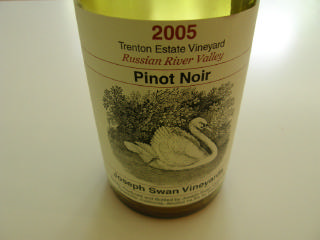 2005 Joseph Swan Vineyards Trenton Estate Vineyard Russian River Valley Pinot Noir 14.3% alc., $47. · Deep, dark ruby color. Terrific rich aromas of black cherry, carnations, and dried roses. Plush black cherry and blackberry fruit that is a bit dusty and herb-tinged. Plenty of joyous fruit, but not jammy or flabby. Good acidity, velvety texture, with some tannin to lose. Thoroughly distinctive and enjoyable. This will only get better with more time in the bottle. One of my All-Americans this year for sure.
Joseph Swan Vineyards is located at 2916 Laguna Rd., Forestville. Tasting and sales are offered on weekends from 11-4:30 as well as by appointment on Mondays and Fridays. The winery is also open many holidays. The website is www.swanwinery.com and the phone is 707-573-3747. Look for Rod in the tasting room most days. Although the winery specializes in Pinot Noir and old vine Zinfandel, a number of other wines such as Chardonnay, Pinot Gris, and Rhones are produced in small quantities. The winery’s wine club is called “Joe’s Drinking Buddies.” The wine label is one of the classiest in the world.
Maurice Wedell: Wedell CellarsMaurice Wedell worked with French restaurateurs until the late 1980s, all the time developing a passion for Burgundian varietals. In 1988, Maurice and his wife Susan moved to the Central Coast of California. The Wedells were determined to plant their own vineyards and make wine. They enlisted the assistance of noted winemaker, John Alban, of Alban Vineyards fame, who guided them in planting a small experimental vineyard of Chardonnay. Their first vintage, in 1994, consisted of one barrel of wine, twenty-eight cases of Chardonnay, from their own grapes and grapes purchased from John Alban. In early 1995, four acres of Chardonnay and one acre of Pinot Noir were densely planted on a steep hillside in the southern end of the Edna Valley. The vineyard began to produce Chardonnay in 1999 and Pinot Noir in 2000. The Hillside Vineyard designation came to represent the best of the estate fruit and a watercolor of this vineyard is proudly displayed on the label of all Wedell Cellars Hillside Vineyard wines. In 2004, the Wedells began to source fruit for a second Pinot Noir from Fiddlestix Vineyard and Ashley’s Vineyard in the Ste. Rita Hills appellation. The Wedell Cellars Santa Rita Hills Pinot Noir was first released in 2004 and features a painting of a grape vine by well known artist Joanne Beaule Ruggles on the label. In 2005, three acres of Chardonnay in the Hillside Vineyard were grafted over to Pinot Noir, increasing the estate Pinot Noir planting to four acres. I ran into Maurice at the recent Fiddlefest held at Fiddlestix Vineyard and I thought the 2006 Wedell Cellars Ste. Rita Hills Pinot Noir was one of the best wines being poured that day. Maurice sent me two bottles of his Pinot Noir to sample. The wines have received considerable praise in the wine press.
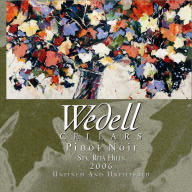 2006 Wedell Cellars Ste. Rita Hills Pinot Noir 14.5% alc., 181 cases, $70. This wine is a blend of Dijon clones 113, 115, 667 and 777 with the majority of the fruit coming from Fiddlestix Vineyard. The harvest in 2006 was extended and delayed, allowing good development of flavors. The grapes were de-stemmed after sorting, with all of the free run juice resulting from the de-stemming discarded. Open top small bin fermenters were employed and indigenous yeasts used. The wine was aged 16 months in 70% new French oak. · Dark reddish-purple robe. Powerful scents of black cherry, sage, and toasty oak. A whiff of alcohol peaks out. There are juicy and succulent dark stone fruits that cascade over the palate and fill the mouth with richness. A citrus note adds interest. The texture is soft and slippery, and there is good grip on the finish. This wine will appeal to fans of fruit-powered, pedal to the metal, Pinot Noir.
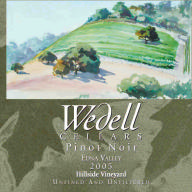 2005 Wedell Cellars Hillside Vineyard Edna Valley Pinot Noir 14.5% alc., 30 cases, $125. Three different Dijon clones - 115, 667, 777 - on low vigor root stock. The goal in planting this clonal/rootstock combination was to delay bud break, increase hang time and acidity, and keep the vineyard’s yield extremely low. The vines are crop thinned to one cluster per shoot. Yields in 2005 from more than 2,300 vines was under 2 tons. Winemaking was the same as noted for the wine above. Aged 20 months in 75% new French oak barrels. · Dark reddish-purple color. Complex nose with bright cherry, a hint of strawberry, dried flowers, fresh ocean air, and a slight vegetal note. Super ripe fruit, approaching raisin, with accents of organic matter, smoke, oak and citrus. Soft and smooth in the mouth with powdery tannins.
Wedell Cellars Pinot Noirs and Chardonnay are for sale on the website at www.wedellcellars.com. Magnums of the Ste. Rita Hills bottling are available as well as a vertical offerings of three vintages of Hillside Vineyard Pinot Noir and three vintages of Ste. Rita Hills Pinot Noir in magnum format. Wedell Wine Club members receive discounts on wines and shipping. 805-489-0596.
C. Donatiello WineryChristopher Donatiello, a former New York based wine and spirits distributor, has teamed with investment banker Bill Hambrecht to totally transform the site of the former Belvedere Winery on Westside Road in Healdsburg. Belvedere Winery was acquired by Bill Hambrecht in 1989. The new spectacular 14.5-acre estate has an organically farmed vineyard, a contemporary wood and glass hospitality center and tasting room designed by noted winery architect and landscaper, Ken Munson, and an organic garden that introduces visitors to flora that have a natural affinity for the aromas found in the Burgundian varietals. The existing winery facility is being upgraded and outfitted with the latest in winemaking technology. A soft launch of the label occurred in April, with the official Grand Opening celebration taking place on June 21, 2008.

 The focus of C. Donatiello Winery is small lot Pinot Noirs and Chardonnays from the organic estate vineyard and specially chosen vineyards in the Russian River Valley. Two very talented winemakers are on board. Winemaker Troy McEnery (photo below on left, Chris on right) has years of experience at Gallo Sonoma and Belvedere, and Associate Winemaker Webster Marquez developed his skills at Williams Selyem and now is partnered with two other winemakers at Anthill Farms. The entire operation is very classy with considerable thought given to a distinguished image and tasteful presentation of the wines.
 I was recently invited to sit down with Chris Donatiello and briefly taste the current inaugural lineup of wines. This winery will be a serious player among the already crowded Middle Reach winery region.
2007 C. Donatiello Russian River Valley Sauvignon Blanc 14.2% alc., 230 cases, $24. From the Crinola Vineyard in Santa Rosa. · A very fruity version of Sauvignon Blanc without the grassiness that can creep in to this varietal. Interesting green apple, pear and mineral notes with acidity nicely corralled. I am not a big Sauvignon Blanc fan, but I enjoyed this wine immensely and thought it compared favorably to Merry Edwards’ version which is my favorite.
2007 C. Donatiello Christie Vineyard Russian River Valley Chardonnay 14.5% alc., 210 cases, $38. · Raised in neutral oak. Austere and steely, with lively acidity. Styled after Chablis. Bring on the oysters.
2006 C. Donatiello Russian River Valley Chardonnay 14.4% alc., 3,400 cases, $28. A blend of several vineyards, primarily Orsi Vineyard. Slight oak influence. · This is fruitier than the above Chardonnay with an understated fullness and richness. Subtle spice, butter and citrus notes.
2006 C. Donatiello Orsi Vineyard Russian River Valley Chardonnay 14.4% alc., 225 cases, $38. The best barrels. Orsi Vineyard is a 30 year-old dry-farmed vineyard on Eastside Road. 50% new oak. · This is a penetrating, full-bodied wine. Brioche, lemon peel, stone fruits, and smoke are profiled. Excellent density and enough acidity to predict a long life ahead.
2006 C. Donatiello Russian River Valley Pinot Noir 14.2% alc., 2,750 cases, $48. A blend from the estate owned Floodgate Vineyard (clones 667, 777) on Trenton Hills Rd (not to be confused with the former Floodgate Vineyard in Anderson Valley), and estate owned Maddie’s Vineyard (Pommard clone), both in the Russian River Valley. Aged in 40% new French oak barrels. · A moderately light wine with admirable finesse. Classic Pinot perfume of red fruits and savory herbs. On the palate there are red stone fruits veering toward raisin. The wine finishes with bracing acidity.
 2006 C. Donatiello Floodgate Vineyard Russian River Valley Pinot Noir 14.3% alc., 175 cases, $57. 35 year-old vineyard planted to Martini clone (UCD 6). Aged in 50% new French oak barrels. · This one was saved for last and no wonder. It has the most striking aromatic and flavor profile which only old vines can offer. Deep on the palate, packed with copious red and black fruits, and nicely complimented by spice and herbs. Despite the evident power, the wine retains an admirable elegance.
2006 C. Donatiello Maddie’s Vineyard Russian River Valley Pinot Noir 14.2% alc., 185 cases, $61. Maddie’s Vineyard is 3½ acres of Pommard clone Pinot Noir planted in 1998. Aged in 50% new French oak barrels. · Attractive aromas of Bing cherry, baking spice and wet oak. Dominated by redder fruits nicely spiced. Supple and plump in the mouth. Well-concealed tannins and a nice acid lift on the finish.
C. Donatiello wines are available through a mailing list (The Cellar List and The Cellar Guild) at www.cdonatiello.com, and in the tasting room which is open daily from 11-5. The winery address is 4035 Westside Road, just a short drive from downtown Healdsburg. Tours of the winery and Aroma Garden are given daily at 12:30 and 2:30. Private tours and tastings are available by appointment. Initimate “Live from the Middle Reach” singer-songwriter ticket performances are scheduled in the Aroma Gardens and complimentary concerts are planned for the first, second and third Sundays of the month. Check the website, www.cdonatiello.com, for schedules. Come for the view (below), stay for the wine.

Bob Iantosca: Gloria Ferrer Caves & VineyardsArtisan wines usually imply a small operation with limited production Why then did I include the large Gloria Ferrer Winery, with more than 330 acres of estate vineyards and a total annual production of 230,000 cases? The reason is that winemaker Bob Iantosca, who has been the chief winemaker at Gloria Ferrer since 1987, has a small separate still Pinot Noir program within Gloria Ferrer, a winery best known for its sparkling wines. Bob crafts about 20,000 cases of five Pinot Noirs that fill out the winery’s lineup of six sparkling wines, one Chardonnay, and one Merlot.
 Gloria Ferrer was founded in 1982 by the Ferrer family, owners of the Freixenet sparkling wine empire based in Spain. The Freixenet Group includes cava producers Freixenet and Segura Viudas, Gloria Ferrer, and still wine properties in many countries including Australia. Gloria Ferrer is named after José Ferrer’s wife, who together direct their wine empire. Originally dedicated to crafting sparkling wine only, still wine production began in the early 1990s. A separate red wine production facility was built and the underground caves expanded to provide storage for both still and sparkling wines. Gloria Ferrer is located on Route 121 (Carneros Hwy) in Sonoma Carneros, a site rumored to have been inspired by Gloria Ferrer herself who picnicked on a Carneros hillside some 35 years ago. I spent some enjoyable time with Bob Iantosca recently on a visit to Gloria Ferrer. He is a laid-back, pony-tailed and bearded character whose relaxed persona hides his tremendous winemaking experience knowledge and experience. With many of my winery visits, the winemaker just wants to get into tasting, but Bob and I sat in his office for a couple of hours just chatting about Pinot Noir before we took a stroll through the modern winery and expansive caves. We never did taste any Pinot Noir, and I frankly preferred spending the time getting to know this skilled winemaker. We first talked about the Gloria Ferrer estate vineyards. There are two adjacent to the winery: Circle Bar Ranch and Home Ranch. The Pinot Noir for the Gloria Ferrer sparkling wines is grown on the flats of the vineyards where the loamy clay soil allows the vines to grow vigorously, producing five to six tons per acre. The Gloria Ferrer sparkling wines are all a blend of Chardonnay and Pinot Noir. Up on the slopes, the soil is poorer, more rocky and volcanic, and Pinot Noir struggles to produce two to three tons per acre, perfect for still Pinot Noir of great character and deep color. The 128-acre Circle Bar Ranch was planted in 1997 and 1998 and is comprised of 13 different blocks. There are seven different soil types and 12 clonal selections giving Bob many opportunities for interesting blending options. The Home Ranch was originally planted in 1984 and has been under continuous redevelopment since. This 207 acre original estate vineyard is comprised of nine distinct blocks, four different soil types, and planted to 15 different clones. Bob will be the first to admit that management of the vineyards is crucial to Gloria Ferrer’s success. Vineyard manager Mike Crumly has been working with Bob for over 20 years planting clones on the estate adapted to specific sites and learning the vagaries of Carneros microclimates. As we walked the property, Bob and I had to fight to keep our caps on. Bob said that the ever-present wind makes it possible to grow grapes in this location, and is largely responsible for coaxing greatness from the region’s vines. Daily fog intrusion here helps the vines to thrive as well. As I tasted through several Gloria Ferrer Pinot Noirs at home, I was struck by their unique and uncommon flavors. I am sure this is in large part to the unique clones used in the wines. A Pinot Noir clone trial was begun as far back as 1988 to study the viticultural differences between 13 clones. Of the 13, a handful emerged and were propagated in larger blocks that now provide the fruit for the wines. The Pinot Noir clones that have shown the greatest promise in the Gloria Ferrer estate vineyards are: Colmar 538 (an Alsatian clone), Martini (UCD 13), Wente, Wädenswil (UCD 2A), Pommard 4, and Dijon 115. Even a little Trefethen Selection shows up in some wines. The resultant wines have great interest since they are not powered solely by Dijon clones as so many California Pinot Noirs are today. Bob uses about 25% to 50% new French oak and ages the Pinot Noirs 9 months in barrel. He feels 11 months in barrel adds too much oak intrusion into the flavors. The grapes are completely de-stemmed. Press and free run wine are kept separate. Some wines are filtered. The alcohol levels are kept quite sensible and all of the wines are medium-weighted with appealing elegance.
2005 Gloria Ferrer Gravel Knob Vineyard Carneros Pinot Noir 13.5% alc., 210 cases. · Dreamy perfume of crushed black cherries, flowers, oak and hay. Substantial raspberry attack on the palate. Softly textured throughout with powdery tannins and a clean and tangy finish. A pleasure to drink and definitely preferable to the 2004 bottling from this vineyard.
2005 Gloria Ferrer José S. Ferrer Selection Carneros Pinot Noir 13.5% alc., 1,067 cases. · Deep, dark stone fruits, cranberry and a touch of herbs on the nose. Plenty of sweet dark fruit extract with retains an appealing suppleness, Primarily fruit-driven with some earth and cedar notes. Beautifully balanced with fine-grained tannins and brisk acidity on the refreshingly clean finish.
2005 Gloria Ferrer Rust Rock Terrace Vineyard Carneros Pinot Noir 13.5% alc., 372 cases. · Very complex aromatic profile consisting of bright black cherry, marzipan, baked cookies, smoke and violets. Earth-dusted black cherry and raspberry fruit which is a touch brambly and tar-infused. Appealing fullness and richness yet elegant in the mouth. Slightly tart on the finish. This one is quite exotic and fun to contemplate.
2005 Gloria Ferrer Estate Carneros Pinot Noir 13.5% alc., 16,962 cases, 993 cases 375ml, $28. Barrel aged for nine months in 25% new oak. Made exclusively from free-run wine. · Lovely red cherry, wild herbs, earth and pine on the nose. Light but satisfying raspberry and cherry flavors with hints of tar, forest floor, herbs and char. Velvety texture, gentle tannins, clean and crisp on the finish. A nice daily drinker.
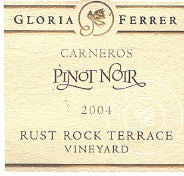 2004 Gloria Ferrer José S. Ferrer Selection Carneros Pinot Noir 13.5% alc., 1,067 cases, $36. A reserve bottling representing a tribute to the Gloria Ferrer founder, José S. Ferrer. Bob hand-selects the 43 best barrels from the estate Carneros vineyards. · Demure scents of black cherry, forest floor and dark chocolate. Beautiful black cherry core with a savory herbal sidecar. Rich but not cloying with polished tannins and a lingering finish. Similar to the Rust Rock Terrace Vineyard wine but with less elegance and more backbone. Excellent.
2004 Gloria Ferrer Gravel Knob Vineyard Carneros Pinot Noir 13.5% alc., 347 cases, $40. Sourced from a rocky part of Home Ranch with well-drained soils. Comar 538 and clone 32. · Requires some time in the glass to open revealing wild berry, black cherry, oak and hay scents. Dusty dark fruits, earth, tobacco and herbs lend interest. Very soft in the mouth. A bit sour on the finish. I could not warm up to this one.
2004 Gloria Ferrer Rust Rock Terrace Vineyard Carneros Pinot Noir 13.5% alc., 124 cases, $40. · Very seductive aromas of cinnamon dosed red cherries. Tenacious red berry and red stone fruit highlighted by carob and sweet spice flavors. Terrific Pinot delicacy in a complete package.
2003 Gloria Ferrer Rust Rock Terrace Vineyard Carneros Pinot Noir 13.5% alc., 375 cases, $40. Rust Rock Terrace consists of five blocks situated on the uppermost hillside of Circle Bar Ranch Vineyard. Clones are 115, Wente, Colmar 538, and Wädenswil. · This bottle seems slightly oxidized. The aromas are evolved to a secondary bouquet of cigar box and prune which carries over into the flavors. Soft in the mouth with a mildly dry finish. For lovers of older Pinot Noirs.
Gloria Ferrer Pinot Noirs (2004 vineyard-designates and 2005 estate) are sold at the winery and are available on the website at www.gloriaferrer.com. These are sensibly priced considering the quality. The charming mission styled visitor center at 23555 Carneros Hwy 121 in Sonoma is open daily for tasting from 10-5. Guided tours are offered daily as well. There is a small charge for tasting and tours. Private tours are available by arrangement. The facility is available for private events and weddings as well. Be sure and wear a cap, it is almost certainly to be breezy. 707-996-7256.
Michael Richmond: Bouchaine
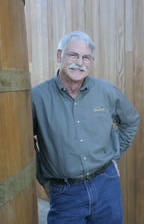 In the search for the next great producer of Pinot Noir, we often forget the established and experienced people in the business. Bouchaine is the oldest continually operated winery in Carneros. It was first planted to vines and orchards by the Carneros legend, Boon Fly, in the mid 1800s. A couple of owners followed, including Italian immigrant Johnny Garetto and the Beringer Brothers. In 1981 the winery was acquired by Burgundian enthusiasts Gerret and Tatiana Copeland. A massive renovation of Bouchaine was undertaken in 1995 and in 2002 Michael Richmond was hired as winemaker and general manager. Michael Richmond (right) is a veteran of over 30 years in the winemaking business. He founded Acacia Winery in Carneros and later managed Carmenet Winery for Chalone. He is one of the co-founders of the Steamboat Pinot Noir Conference in Oregon. As an avid cyclist, you may pass him on your travels in Carneros.
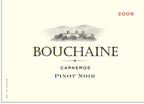 2005 Bouchaine Napa Carneros Pinot Noir 13.5% alc., $20 (website retail for the 2006 vintage is $30). Dijon, Pommard clones and Swan selection. · Deep ruby color. Flat out terrific nose featuring black cherries, shrooms, dark chocolate, and smoke. A beautiful drink of Pinot. Darkly fruited and substantial, yet smooth, light and elegant. Very easy to like. I call this a “Just Right” wine since everything about it is harmonious. There isn’t another Pinot Noir in this issue that can match the quality here at such a low price. For value seeking Pinot lovers who want something they can count on.
Bouchaine Vineyards is now offering their 2006 vintage of the above wine and the 2005 Bouchaine Estate Pinot Noir ($40) on the website at www.bouchaine.com. There is also decent retail distribution. The winery is open to visitors daily from 10:30-4. The address is 1075 Buchli Station Rd, Napa. The phone is 800-654-WINE.
Is Pinot Noir Recession Proof?Prices for premium Pinot Noir seem to inch up with each vintage. The average price for all of the Pinot Noirs reviewed in this issue is $54. The economy is in the doldrums and seems to be worsening with each bit of bad news that surfaces daily. As report published in SFGate.com (May 7, 2008) by Silicon Valley Bank’s Wine Division (500 wineries were polled in California, Oregon, and Washington) indicated that high-end wines above $15 a bottle may suffer a decrease in sales over the next year. Premium wine sales have been growing around 20 percent a year for some time now, but the growth rate may drop into the low teens. This has not seemed to detour new Pinot Noir producers from entering the fray. How will we know when we are in a Pinot Noir recession?
You know there is a Pinot Noir recession when…… You walk into your local fine wine store and there are more sales associates standing around than customers in the store (I have noticed this recently). More wine cellars are for sale on the auction market or at least being paired down (a real observation of late). A new business surfaces called “Wine Repo Man,” which hauls off your wine to pay your bills. People begin recycling their empty wine bottles (you can get $6.50 per dozen depending on the color - green glass is hard to recycle) Wine lovers begin selling their used corks. Restaurants stop selling their highly marked-up wine as cash-strapped customers bring their own. The ridiculous acceleration in wine auction prices begins reversing (may not be observed as the many billionaires who buy cult wines have an inexhaustible thirst and bank roll). The press begins predicting doom and gloom due to high wine prices in a weak economy. Two Buck Chuck becomes Three Buck Chuck. Sales of half bottles increase. Wineries start offering 0% financing for 12 months for Pinot Noir purchases. Wineries start shipping wine by horse-drawn trailers. Wineries start cellaring wine for customers (they can’t afford to drive to pick it up or pay for shipping). And finally, winemakers begin drinking even more beer.
Pinot Briefs
 Winery Acquisitions by Leslie Rudd Rudd, along with business partner Pat Roney, owns interests in a number of specialty food stores in Northern California including Oakville Grocery and Dean & Deluca (now worldwide), a restaurant in Napa, and six wineries. He transformed Girard Winery into Rudd Winery, together with Roney purchased Windsor Vineyards in 2007, acquired Grove Street Winery in Healdsburg in 2008 and has now entered the Pinot race. Rudd and Roney bought Sonoma Coast Vineyards in Forestville and according to the Wine Spectator (June 27, 2008), will ramp up production from 4,000 to 20,000 cases. In addition, they have started a new label, Windsor Sonoma Winery, with planned future production of 50,000 cases of Pinot Noir and Chardonnay.
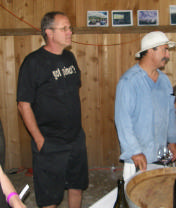 Story Behind Billionaire’s Vinegar to be a Movie I recently reviewed the book Billionaire’s Vinegar about sleuthing out fake old vintages of fine wine. Two Hollywood production companies are planning to make a film about billionaire William Koch’s lawsuit directed at Hardy Rodenstock who allegedly sold Koch phony Thomas Jefferson wines. Genetic Code of Pierce’s Disease Bacterium Cracked According to Kevin McCallum, writing in The Press Democrat (June 19, 2008), Steven Lindow, a professor of plant biology at University California Berkeley, has found the genetic code of the bacterium that causes Pierce’s disease. In addition, he has determined how to stop the bacteria’s spread through a grapevine by isolating the molecule that allows bacteria to signal each another. Using this discovery, a bacterium can be tricked into thinking the vine is crowded with other bacteria and it reverts to a slow growth rate or shuts down completely. This finding may lead to a spray that can cure’s Pierce’s disease.
 Organic Wine Journal The Organic Wine Journal is the leading online source of organic and biodynamic wine news worldwide. The website, www.organicwinejournal.com, has been re-launched with a new layout and expanded content. Pinot Noir from France The French have finally agreed to allow their wineries to market their wines in New World style. To compete in the world wine market, the French have left tradition behind, and now allow mid-quality wine to be labeled by grape variety, for example rather than origin. They also will permit the use of oak alternatives (chips for example), added tannins and enzymes, and other nontraditional “New World” winemaking techniques. Sacré bleu!
ravi Instant Wine Chiller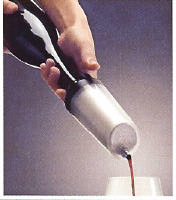 This is a new invention introduced into the United States from Canada in May, 2008. The shell of the device is placed in the freezer and works like a thermos. The internal stainless tube maintains the wine’s characteristics and does not alter the taste. When a wine at room temperature is to be served, it can be poured through the device, chilling the wine to between 55 and 65°F in seconds. Sleek, ergonomic, and easy to clean. It is ideal for wines just purchased, or not stored in a cellar, or for wines kept at room temperature. I personally tried the chiller on several Pinot Noirs and was impressed by how easy it was to use and how effective it was in bringing the wine to optimal drinking temperature. Stick it back in the freezer, and use it again when you pour that second glass. Retail price is $49.95. Visit the website, www.ravisolution.com for
The Long and Winding Pinot Road, Part XIIIAs the years and weekly issues rolled by, I was infusing the PinotFile with a purpose. I chose to circumvent the many wine publications of the time which centered primarily around lengthy lists of tasting notes and scores. My intent was to find and report the compelling stories behind every good bottle of Pinot Noir. Because of the serious commitment in time, effort, and money that Pinot Noir producers put into the bottle, I avoided writing derogatory reviews of Pinot Noirs that were not appealing to me. I strove to give a truthful judgment and only feature and recommend Pinot Noirs that I deemed worthy of reader interest. That said, I have always emphasized that we all have different palates with no one person tasting the same, so the recommended wines were meant to be only a starting point for the reader’s own exploration of Pinot Noir. I have received a continuous stream of testimonials from grateful readers who seem happy with my unpretentious and humorous approach to reviewing wine, and I am truly appreciative of each and every one. W.S. Merwin wrote, “I asked how can you ever be sure that what you write is really any good at all… … If you have to be sure don’t write.” The feedback I have received has spurred me on and given me some surety. I particularly enjoyed one bit of feedback I received: “If I drank over 1,300 wines during the year, my wife would accuse me of having a drinking problem. You do it, call it research, brag about it, and gain respect among your friends. Way to go!” The PinotFile currently has readers from all over the globe including Australia, Canada, the European Union, France, Germany, Great Britain, Hong Kong, Japan, Netherlands, New Zealand, Peru, Singapore, Spain, Sweden, Switzerland, and many other countries as well. I have now published 318 issues of the PinotFile including this issue. It has been a joyous cold soak, but its time to pull the cork on a new venture. To be continued… … … .. |